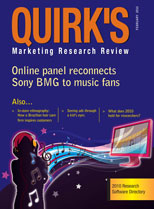Editor's note: Leslie M. Harris is managing partner and founder of Mature Marketing & Research LLC, Teaneck, N.J. He can be reached at 201-836-7486 or at mmrharris@aol.com. Paul Johnson is principal of PEJ Consulting, a Cedar Knolls, N.J., market research consultancy. He can be reached at 973-998-6251 or at pejconsulting@hotmail.com. This article appeared in the February 8, 2010, edition of Quirk's e-newsletter.
Marketing to an older population doesn't have to feel old. In fact, it shouldn't. As it turns out, often what's relevant and meaningful to grandparents is not old at all: grandchildren. The grandparent-grandchild relationship is quickly bringing mature consumers into the 21st century and proving that the grandparent market has potential beyond the health care and financial services industries. Grandchildren have special influence with mature audiences, as they reinvigorate the hope, love, renewal and motivations that grandparents once had when their children were growing up. These are powerful motivators that can dislodge discretionary dollars that might be lingering in CDs, in a bank or simply in the cookie jar. Leveraging the grandparent-grandchild relationship can be a powerful tool that tugs on the heartstrings of a mature audience and still incorporates a modern, accessible, cross-generational message.
Right sentiment, right meaning, right time
The idea is for brands of all stripes to create grandparent-grandchild "Hallmark moments" via marketing messages and products/experiences that bring the right sentiment with the right meaning at the right time. It's not simply the gratuitous use of kids (or animals) but the defining moments that remind grandparents and grandchildren (and the parents who are often the go-between) of how Brand X can foster that special relationship. The message can be fun, sentimental or even practical, but it should always leave the viewer feeling that they'd better sit down if they aren't already - and maybe grab a tissue. Firms in a variety of industries that depend on mature audiences, including retail banking, insurance, travel and tourism and hospitality, have successfully demonstrated how to use the relationship between grandparents and their grandchildren in their marketing campaigns.
For example, Walmart began a program in 2004 to celebrate Grandparents Day with a store sale and a $500 grant for each store. The grants allowed Walmart associates to donate to local youth groups to encourage connecting with seniors in their area and foster a closer bond not only with their own grandparents but with those in the community that are sometimes forgotten.
ING offers specific trust products and plans that highlight the grandparent-grandchild relationship. The trust division offers both life insurance and multigeneration trust instruments. ING went to great lengths to understand the motivations and financial product needs of grandparents and discovered that grandparents might provide for grandchildren and not for their children due to a falling out or parting of ways.
Disney makes a particularly special effort to connect grandparents and grandchildren, presenting "grandtraveling" as a package of park passes, special lodgings and other considerations that are all meant to make the experience memorable for both grandparent and child.
So if you're thinking about how your brand can construct a modern Hallmark moment that resonates across three generations, here are a few grandparent-specific rules to follow1:
Plan for life-stage changes. The time between parents becoming empty nesters and grandparents is changing the behaviors of maturing households. Couples who now have time to reconnect as they did before children are more likely to take on new challenges, discover new places and generally do things that parenting kept them from doing. Marketers should remember how ethnicity and nationality contribute to attitudes and attempt to incorporate a sense of generational continuity around events that celebrate heritage. For example, marketers can take advantage of low-cost, high-impact sponsorships at events that include extended families such as St. Patrick's Day or Columbus Day in New York or Cinco de Mayo in Los Angeles and Miami.
Approach communications to grandparents without bias. Grandparents aren't your vision of old folks anymore. Look for that Hallmark moment for your product in the context of the grandparent-grandchild relationship.
Tactfully incorporate the physiological effects of grandparenthood in your designs. There are no contemporary versions of Norman Rockwell's portraits, such as the Saturday Evening Post's cover of the Thanksgiving dinner. The challenge is to find the moments that represent contemporary people in the context of today's more complex family structures. This allows a creative director to make his or her contemporary statement of the Hallmark moment.
Powerful, emotive message
Grandparents are not homogenous, but they are highly susceptible to a powerful, emotive message that reminds them of their connection to younger generations. Today's grandparents are doing more than riding off into the sunsets of their lives: they're in-touch, grandkid-conscious, vacation-destination-decision-making beneficiaries who think far beyond their own age group. By keeping these characteristics in mind, companies that help maximize the benefits of the grandparent-grandchild relationship can position themselves to be on the receiving end of grandparents' sought-after discretionary dollars.
References
1 After 60, Harris & Edelman, 2006
